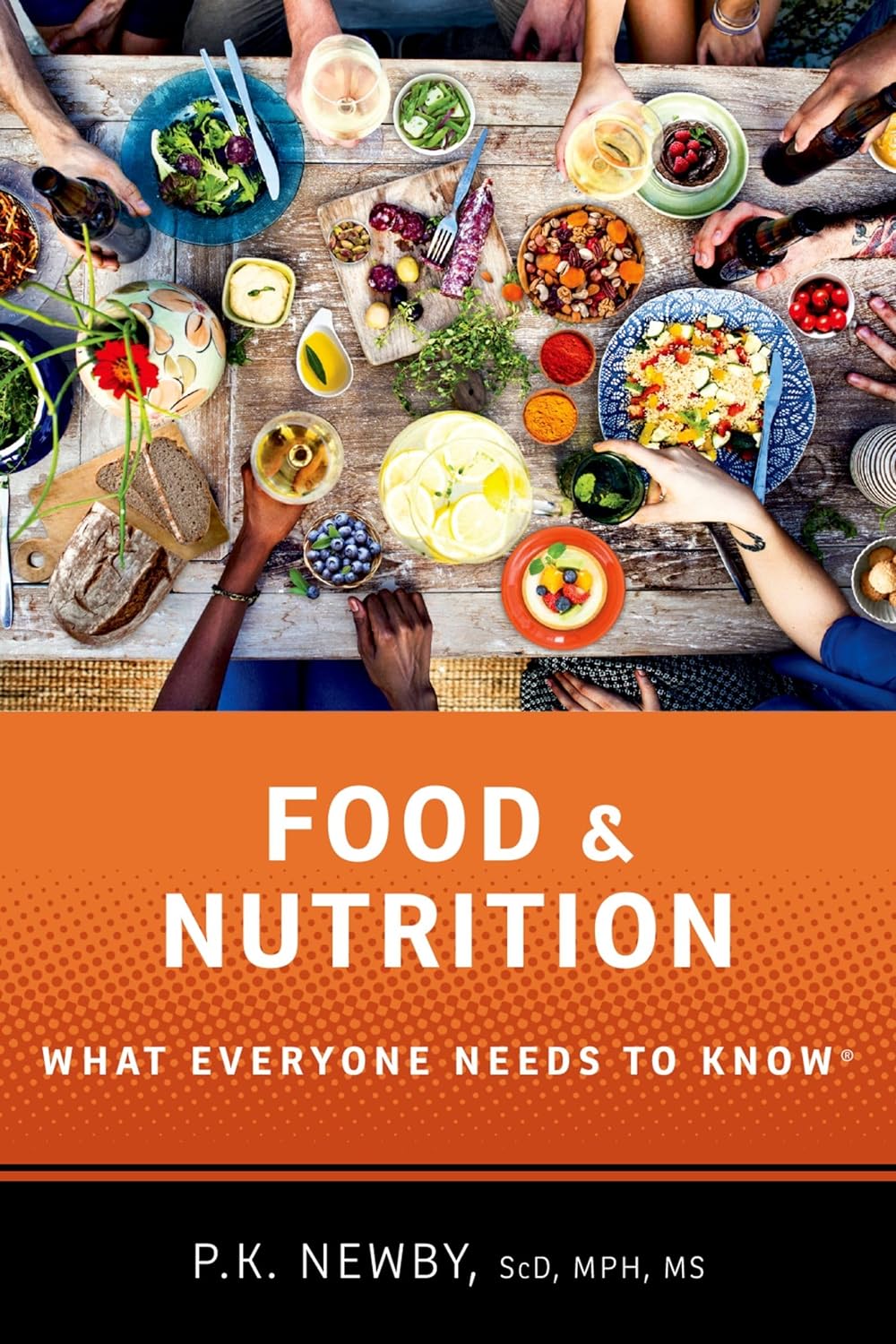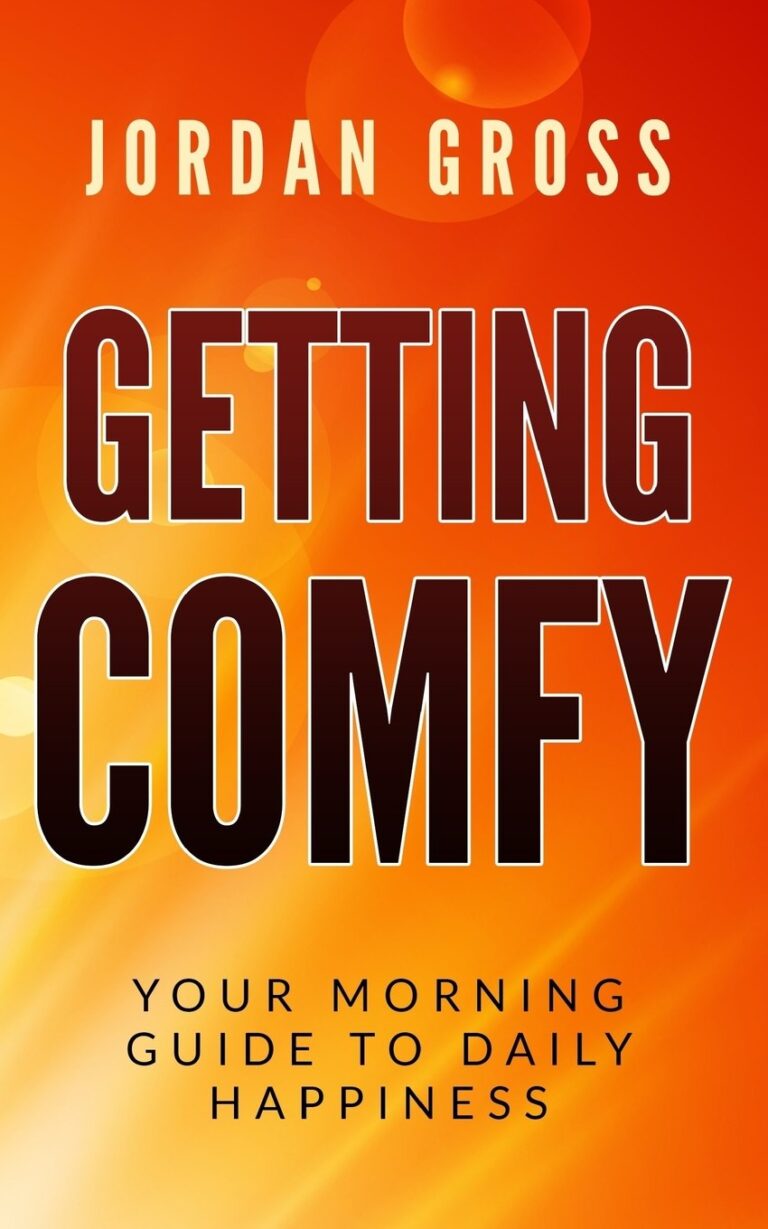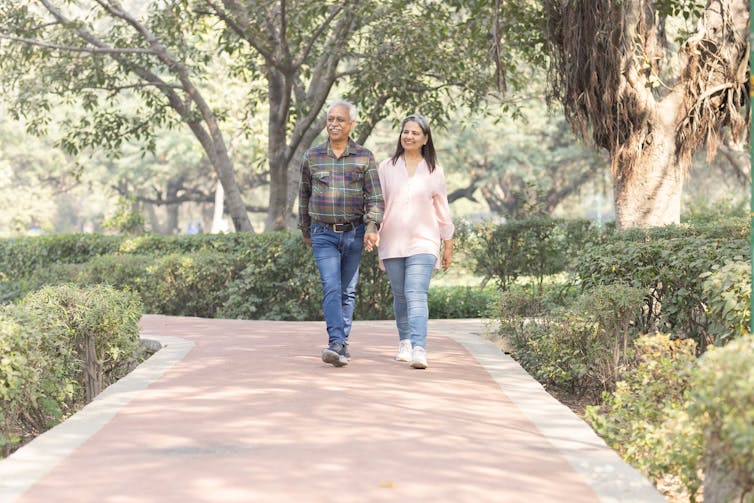
Food and Nutrition – by Dr. P.K. Newby
10almonds is reader-supported. We may, at no cost to you, receive a portion of sales if you purchase a product through a link in this article.
The “What Everyone Needs To Know” part of the title is the name of a series of books, of which this one, “Food and Nutrition”, is one.
In this case, the title is apt, and/or could have been “What Everyone Really Should Know”, or “What Everyone Would Like To Think They Know But Have Often Just Been Bluffing Their Way Through The Supermarket Aisles”.
The chapter and section headings are all in the forms of questions, such that all-together in such volume in the table of contents, they’re reminiscent of the “Jonathan Frakes Asks You Things” meme.
But, this serves a dual purpose—for one, it makes the whole book one big FAQ, which is a very convenient format. Furthermore, it prompts a little thought on the part of the reader before each section, if we indeed question for ourselves:
- Are fertilizers in farming friend or foe?
- How have the Digital Revolution and Information Age impacted our diet?
- Are canned and frozen foods inferior to fresh?
- Does snacking or meal timing matter?
- What are cereal grains and “pseudograins”?
…And so many more. But what’s best about this is:
Dr. Newby doesn’t reference her own preferences, or even have a particular way of eating she’d like us to adopt. She just lays out the science to answer each question, as discovered by high-quality studies and a general weight of evidence.
Bottom line: this book can level-up your nutritional knowledge from bluffing to really knowing! A worthy addition to anyone’s bookshelf.
Don’t Forget…
Did you arrive here from our newsletter? Don’t forget to return to the email to continue learning!
Recommended
Learn to Age Gracefully
Join the 98k+ American women taking control of their health & aging with our 100% free (and fun!) daily emails:
-
What is AuDHD? 5 important things to know when someone has both autism and ADHD
10almonds is reader-supported. We may, at no cost to you, receive a portion of sales if you purchase a product through a link in this article.
You may have seen some new ways to describe when someone is autistic and also has attention-deficit hyperactivity disorder (ADHD). The terms “AuDHD” or sometimes “AutiADHD” are being used on social media, with people describing what they experience or have seen as clinicians.
It might seem surprising these two conditions can co-occur, as some traits appear to be almost opposite. For example, autistic folks usually have fixed routines and prefer things to stay the same, whereas people with ADHD usually get bored with routines and like spontaneity and novelty.
But these two conditions frequently overlap and the combination of diagnoses can result in some unique needs. Here are five important things to know about AuDHD.
Kosro/Shutterstock 1. Having both wasn’t possible a decade ago
Only in the past decade have autism and ADHD been able to be diagnosed together. Until 2013, the Diagnostic and Statistical Manual of Mental Disorders (DSM) – the reference used by health workers around the world for definitions of psychological diagnoses – did not allow for ADHD to be diagnosed in an autistic person.
The manual’s fifth edition was the first to allow for both diagnoses in the same person. So, folks diagnosed and treated prior to 2013, as well as much of the research, usually did not consider AuDHD. Instead, children and adults may have been “assigned” to whichever condition seemed most prominent or to be having the greater impact on everyday life.
2. AuDHD is more common than you might think
Around 1% to 4% of the population are autistic.
They can find it difficult to navigate social situations and relationships, prefer consistent routines, find changes overwhelming and repetition soothing. They may have particular sensory sensitivities.
ADHD occurs in around 5–8% of children and adolescents and 2–6% of adults. Characteristics can include difficulties with focusing attention in a flexible way, resulting in procrastination, distraction and disorganisation. People with ADHD can have high levels of activity and impulsivity.
Studies suggest around 40% of those with ADHD also meet diagnostic criteria for autism and vice versa. The co-occurrence of having features or traits of one condition (but not meeting the full diagnostic criteria) when you have the other, is even more common and may be closer to around 80%. So a substantial proportion of those with autism or ADHD who don’t meet full criteria for the other condition, will likely have some traits.
3. Opposing traits can be distressing
Autistic people generally prefer order, while ADHDers often struggle to keep things organised. Autistic people usually prefer to do one thing at a time; people with ADHD are often multitasking and have many things on the go. When someone has both conditions, the conflicting traits can result in an internal struggle.
For example, it can be upsetting when you need your things organised in a particular way but ADHD traits result in difficulty consistently doing this. There can be periods of being organised (when autistic traits lead) followed by periods of disorganisation (when ADHD traits dominate) and feelings of distress at not being able to maintain organisation.
There can be eventual boredom with the same routines or activities, but upset and anxiety when attempting to transition to something new.
Autistic special interests (which are often all-consuming, longstanding and prioritised over social contact), may not last as long in AuDHD, or be more like those seen in ADHD (an intense deep dive into a new interest that can quickly burn out).
Autism can result in quickly being overstimulated by sensory input from the environment such as noises, lighting and smells. ADHD is linked with an understimulated brain, where intense pressure, novelty and excitement can be needed to function optimally.
For some people the conflicting traits may result in a balance where people can find a middle ground (for example, their house appears tidy but the cupboards are a little bit messy).
There isn’t much research yet into the lived experience of this “trait conflict” in AuDHD, but there are clinical observations.
4. Mental health and other difficulties are more frequent
Our research on mental health in children with autism, ADHD or AuDHD shows children with AuDHD have higher levels of mental health difficulites than autism or ADHD alone.
This is a consistent finding with studies showing higher mental health difficulties such as depression and anxiety in AuDHD. There are also more difficulties with day-to-day functioning in AuDHD than either condition alone.
So there is an additive effect in AuDHD of having the executive foundation difficulties found in both autism and ADHD. These difficulties relate to how we plan and organise, pay attention and control impulses. When we struggle with these it can greatly impact daily life.
5. Getting the right treatment is important
ADHD medication treatments are evidence-based and effective. Studies suggest medication treatment for ADHD in autistic people similarly helps improve ADHD symptoms. But ADHD medications won’t reduce autistic traits and other support may be needed.
Non-pharmacological treatments such as psychological or occupational therapy are less researched in AuDHD but likely to be helpful. Evidence-based treatments include psychoeducation and psychological therapy. This might include understanding one’s strengths, how traits can impact the person, and learning what support and adjustments are needed to help them function at their best. Parents and carers also need support.
The combination and order of support will likely depend on the person’s current functioning and particular needs. https://www.youtube.com/embed/pMx1DnSn-eg?wmode=transparent&start=0 ‘Up until recently … if you had one, you couldn’t have the other.’
Do you relate?
Studies suggest people may still not be identified with both conditions when they co-occur. A person in that situation might feel misunderstood or that they can’t fully relate to others with a singular autism and ADHD diagnosis and something else is going on for them.
It is important if you have autism or ADHD that the other is considered, so the right support can be provided.
If only one piece of the puzzle is known, the person will likely have unexplained difficulties despite treatment. If you have autism or ADHD and are unsure if you might have AuDHD consider discussing this with your health professional.
Tamara May, Psychologist and Research Associate in the Department of Paediatrics, Monash University
This article is republished from The Conversation under a Creative Commons license. Read the original article.
Share This Post
-
Why are people on TikTok talking about going for a ‘fart walk’? A gastroenterologist weighs in
10almonds is reader-supported. We may, at no cost to you, receive a portion of sales if you purchase a product through a link in this article.
“Fart walks” have become a cultural phenomenon, after a woman named Mairlyn Smith posted online a now-viral video about how she and her husband go on walks about 60 minutes after dinner and release their gas.
Smith, known on TikTok as @mairlynthequeenoffibre and @mairlynsmith on Instagram, has since appeared on myriad TV and press interviews extolling the benefits of a fart walk. Countless TikTok and Instagram users and have now shared their own experiences of feeling better after taking up the #fartwalk habit.
So what’s the evidence behind the fart walk? And what’s the best way to do it?
CandyBox Images/Shutterstock Exercise can help get the gas out
We know exercise can help relieve bloating by getting gas moving and out of our bodies.
Researchers from Barcelona, Spain in 2006 asked eight patients complaining of bloating, seven of whom had irritable bowel syndrome, to avoid “gassy” foods such as beans for two days and to fast for eight hours before their study.
Each patient was asked to sit in an armchair, in order to avoid any effects of body position on the movement of gas. Gas was pumped directly into their small bowel via a thin plastic tube that went down their mouth, and the gas expelled from the body was collected into a bag via a tube placed in the rectum. This way, the researchers could determine how much gas was retained in the gut.
The patients were then asked to pedal on a modified exercise bike while remaining seated in their armchairs.
The researchers found that much less gas was retained in the patients’ gut when they exercised. They determined exercise probably helped the movement and release of intestinal gas.
Walking may have another bonus; it may trigger a nerve reflex that helps propel foods and gas contents through the gut.
Walking can also increase internal abdominal pressure as you use your abdominal muscles to stay upright and balance as you walk. This pressure on the colon helps to push intestinal gas out.
Proper fart walk technique
One study from Iran studied the effects of walking in 94 individuals with bloating.
They asked participants to carry out ten to 15 minutes of slow walking (about 1,000 steps) after eating lunch and dinner. They filled out gut symptom questionnaires before starting the program and again at the end of the four week program.
The researchers found walking after meals resulted in improvements to gut symptoms such as belching, farting, bloating and abdominal discomfort.
Now for the crucial part: in the Iranian study, there was a particular way in which participants were advised to walk. They were asked to clasp hands together behind their back and to flex their neck forward.
The clasped hands posture leads to more internal abdominal pressure and therefore more gentle squeezing out of gas from the colon. The flexed neck posture decreases the swallowing of air during walking.
This therefore is the proper fart walk technique, based on science.
Could walking with your hands behind your back yield better or more farts? candy candy/Shutterstock What about constipation?
A fart walk can help with constipation.
One study involved middle aged inactive patients with chronic constipation, who did a 12 week program of brisk walking at least 30 minutes a day – combined with 11 minutes of strength and flexibility exercises.
This program, the researchers found, improved constipation symptoms through reduced straining, less hard stools and more complete evacuation.
It also appears that the more you walk the better the benefits for gut symptoms.
In patients with irritable bowel syndrome, one study increasing the daily step count to 9,500 steps from 4,000 steps led to a 50% reduction in the severity of their symptoms.
And just 30 minutes of a fart walk has been shown to improve blood sugar levels after eating.
Walking after eating can help keep your blood sugar levels under control. IndianFaces/Shutterstock What if I can’t get outside the house?
If getting outside the house after dinner is impossible, could you try walking slowly on a treadmill or around the house for 1,000 steps?
If not, perhaps you could borrow an idea from the Barcelona research: sit back in an armchair and pedal using a modified exercise bike. Any type of exercise is better than none.
Whatever you do, don’t be a couch potato! Research has found more leisure screen time is linked to a greater risk of developing gut diseases.
We also know physical inactivity during leisure time and eating irregular meals are linked to a higher risk of abdominal pain, bloating and altered bowel motions.
Try the fart walk today
It may not be for everyone but this simple physical activity does have good evidence behind it. A fart walk can improve common symptoms such as bloating, abdominal discomfort and constipation.
It can even help lower blood sugar levels after eating.
Will you be trying a fart walk today?
Vincent Ho, Associate Professor and clinical academic gastroenterologist, Western Sydney University
This article is republished from The Conversation under a Creative Commons license. Read the original article.
Share This Post
-
How To April Fool Yourself Into Having A Nutrient-Dense Diet!
10almonds is reader-supported. We may, at no cost to you, receive a portion of sales if you purchase a product through a link in this article.
These nutrient-dense foods pack such a punch you only need a bit added to your meal…
- “Have 5 servings of fruit per day”—popular wisdom in the West
- “Have 7 servings of fruit per day!”—generally held as the norm in Japan
- “Have these 12 things that are mostly fruit & veg & nuts each day”—Dr. Greger’s Daily Dozen
- “Does the pickle that comes with a burger count?”—an indication of how much many people struggle.
For what it’s worth: pickles are a good source of some minerals (and some healthy gut bacteria too), but are generally too high in sodium to be healthy for most people beyond in the most modest moderation.
But! It can be a lot easier, and without sitting down to a salad buffet every day!
Here are some sneaky tips:
(call it our nod to April Fool’s Day, because tricking yourself into eating more healthily is a top-tier prank)
Beyond soups and smoothies
Soups and smoothies are great, because we can take a lot of nutrients that way without actually oing much eating. And if we’ve a want or need to hide something, blending it does a fine job. However, we’re confident you already know how to make soups and smoothies. So…
Sauces are another excellent place to put nutrients—and as a bonus, homemade sauces will mean skipping on the store-bought sauces whose ingredients all-too-often look something like “sugar, water, spirit vinegar, glucose-fructose syrup, modified maize starch, maltodextrin, salt…”
Top things to use as a main base ingredient in sauces:
- Tomato purée—so much lycopene, and great vitamins too! Modest flavour, but obviously only sensible for what you intend to be a tomato-based sauce. Use it to make anything from marinara sauce to ketchup, sweet-and-sour to smoky barbecue.
- Lentils/beans—if unsure, red lentils or haricot beans have a very mild taste, and edamame beans are almost not-there, flavor-wise. But cooked and blended smooth, these are high-protein, iron-rich, flavonoid-heavy, and a good source of fiber too. Can be used as the base of so many savory creamy sauces!
- Corn—that yellow color? It’s all the lutein. Home-made creamed corn goes great as a dipping sauce! Added spices optional.
Vegetables that punch above their weight
Sometimes, you might not want to eat much veg, but a small edible side-dish could be appealing, or even a generous garnish. In those cases, if you choose wisely, you can have a lot of nutrients in a tiny portion. Here are some that have an absurd nutrient-to-size ratio:
Cacao nibs—one for the dessert-lovers here, but can also garnish a frothy coffee, your morning overnight oats, or if we’re honest, can also just be snacked on! And they keep for ages. Botanically technically a fruit, but we’re going to throw it in here. As for health qualities? Where to begin…
They:
- are full of antioxidants and fight inflammation
- boost immune health
- help control blood sugar levels
- improve vascular function and heart health
- and even fight cancer, which is a many-headed beast, but for example:
…which is starting to look like a pattern, isn’t it? It’s good against cancer.
Brussels sprouts—if your knee-jerk reaction here wasn’t one of great appeal, then consider: these are delicious if done right.
Buy them fresh, not frozen (nothing nutritionally wrong with frozen if you like them—we’re just doing the extra-level tastiness here). Wash them and peel them, then cut twice from the top to almost-the-bottom, to quarter them in a way that they still stay in one piece. Rub them (or if you’re going easier on the fats, spray them) with a little olive oil, a tiny touch of lemon juice, and sprinkle a little cracked black pepper. Sautée them. We know people will advise roasting, which is also great, but try the sautée approach, and thank us later.
Four sprouts is already a sufficient daily serving of cruciferous vegetables, and provides so many health benefits, with not just a stack of vitamins and minerals, but also have anti-cancer properties, are great for your heart in multiple ways, and reduce inflammation too. They’re literally one of the healthiest foods out there and you only need a tiny portion to benefit.
Kale—Don’t like the taste/texture? That’s OK, read on… No surprises here, but it’s crammed with vitamins and minerals.
- If you don’t care for the bitter taste, cooking it (such as by steaming it) takes that away.
- If you don’t care for the texture, baking it with a little sprayed-on olive oil changes that completely (and is how “kale chips” are made).
- If you don’t care for either? Do the “kale chips” thing mentioned above, but do it on a lower heat for longer—dry it out, basically. Then either blend it in a food processor, or by hand with a pestle and mortar (it turns to powder very easily, so this won’t be hard work), and you now have a very nutrient-dense powder that tastes of very little. While fries are not a health food, an example here is that you can literally dust fries with it and they won’t taste any different but you got a bunch of vitamins and minerals added from a whole food source.
- If going for the above approach, do it in batch and make yourself a jar of it to keep handy with your seasonings collection!
Bell peppers—Working hard to justify their high prices in the grocery store, these are very high in vitamins, especially rich in carotenoids, including lutein, and as a bonus, they’re also full of antioxidants. So, slice some and throw them at whatever else you’re cooking, and you’ve added a lot of nutrients for negligible effort.
Garlic—once you’ve done the paperwork, garlic not only makes bland meals delicious, but is also a treasure trove of micronutrients. It has a stack of vitamins and minerals, and also contains allicin. If you’ve not heard of that one, it’s the compound in garlic that is so good for blood pressure and heart health. See for example:
- Lipid-lowering effects of time-released garlic
- Garlic extract lowers blood pressure in patients with hypertension
- Garlic extract reduces blood pressure in hypertensives
If an apple a day keeps the doctor away, just imagine what a bulb of garlic can do (come on, we can’t be the only ones who measure garlic by the bulb instead of by the clove, right?)!
But in seriousness: measure garlic with your heart—have lots or a little, per your preference. The whole point here is that even a little of these superfoods can make a huge difference to your health!
Share This Post
Related Posts
-
How To Leverage Attachment Theory In Your Relationship
10almonds is reader-supported. We may, at no cost to you, receive a portion of sales if you purchase a product through a link in this article.
How To Leverage Attachment Theory In Your Relationship
Attachment theory has come to be seen in “kids nowadays”’ TikTok circles as almost a sort of astrology, but that’s not what it was intended for, and there’s really nothing esoteric about it.
What it can be, is a (fairly simple, but) powerful tool to understand about our relationships with each other.
To demystify it, let’s start with a little history…
Attachment theory was conceived by developmental psychologist Mary Ainsworth, and popularized as a theory bypsychiatrist John Bowlby. The two would later become research partners.
- Dr. Ainsworth’s initial work focused on children having different attachment styles when it came to their caregivers: secure, avoidant, or anxious.
- Later, she would add a fourth attachment style: disorganized, and then subdivisions, such as anxious-avoidant and dismissive-avoidant.
- Much later, the theory would be extended to attachments in (and between) adults.
What does it all mean?
To understand this, we must first talk about “The Strange Situation”.
“The Strange Situation” was an experiment conducted by Dr. Ainsworth, in which a child would be observed playing, while caregivers and strangers would periodically arrive and leave, recreating a natural environment of most children’s lives. Each child’s different reactions were recorded, especially noting:
- The child’s reaction (if any) to their caregiver’s departure
- The child’s reaction (if any) to the stranger’s presence
- The child’s reaction (if any) to their caregiver’s return
- The child’s behavior on play, specifically, how much or little the child explored and played with new toys
She observed different attachment styles, including:
- Secure: a securely attached child would play freely, using the caregiver as a secure base from which to explore. Will engage with the stranger when the caregiver is also present. May become upset when the caregiver leaves, and happy when they return.
- Avoidant: an avoidantly attached child will not explore much regardless of who is there; will not care much when the caregiver departs or returns.
- Anxious: an anxiously attached child may be clingy before separation, helplessly passive when the caregiver is absent, and difficult to comfort upon the caregiver’s return.
- Disorganized: a disorganizedly attached child may flit between the above types
These attachment styles were generally reflective of the parenting styles of the respective caregivers:
- If a caregiver was reliably present (physically and emotionally), the child would learn to expect that and feel secure about it.
- If a caregiver was absent a lot (physically and/or emotionally), the child would learn to give up on expecting a caregiver to give care.
- If a caregiver was unpredictable a lot in presence (physical and/or emotional), the child would become anxious and/or confused about whether the caregiver would give care.
What does this mean for us as adults?
As we learn when we are children, tends to go for us in life. We can change, but we usually don’t. And while we (usually) no longer rely on caregivers per se as adults, we do rely (or not!) on our partners, friends, and so forth. Let’s look at it in terms of partners:
- A securely attached adult will trust that their partner loves them and will be there for them if necessary. They may miss their partner when absent, but won’t be anxious about it and will look forward to their return.
- An avoidantly attached adult will not assume their partner’s love, and will feel their partner might let them down at any time. To protect themself, they may try to manage their own expectations, and strive always to keep their independence, to make sure that if the worst happens, they’ll still be ok by themself.
- An anxiously attached adult will tend towards clinginess, and try to keep their partner’s attention and commitment by any means necessary.
Which means…
- When both partners have secure attachment styles, most things go swimmingly, and indeed, securely attached partners most often end up with each other.
- A very common pairing, however, is one anxious partner dating one avoidant partner. This happens because the avoidant partner looks like a tower of strength, which the anxious partner needs. The anxious partner’s clinginess can also help the avoidant partner feel better about themself (bearing in mind, the avoidant partner almost certainly grew up feeling deeply unwanted).
- Anxious-anxious pairings happen less because anxiously attached people don’t tend to be attracted to people who are in the same boat.
- Avoidant-avoidant pairings happen least of all, because avoidantly attached people having nothing to bind them together. Iff they even get together in the first place, then later when trouble hits, one will propose breaking up, and the other will say “ok, bye”.
This is fascinating, but is there a practical use for this knowledge?
Yes! Understanding our own attachment styles, and those around us, helps us understand why we/they act a certain way, and realize what relational need is or isn’t being met, and react accordingly.
That sometimes, an anxiously attached person just needs some reassurance:
- “I love you”
- “I miss you”
- “I look forward to seeing you later”
That sometimes, an avoidantly attached person needs exactly the right amount of space:
- Give them too little space, and they will feel their independence slipping, and yearn to break free
- Give them too much space, and oops, they’re gone now
Maybe you’re reading that and thinking “won’t that make their anxious partner anxious?” and yes, yes it will. That’s why the avoidant partner needs to skip back up and remember to do the reassurance.
It helps also when either partner is going to be away (physically or emotionally! This counts the same for if a partner will just be preoccupied for a while), that they parameter that, for example:
- Not: “Don’t worry, I just need some space for now, that’s all” (à la “I am just going outside and may be some time“)
- But: “I need to be undisturbed for a bit, but let’s schedule some me-and-you-time for [specific scheduled time]”.
Want to learn more about addressing attachment issues?
Psychology Today: Ten Ways to Heal Your Attachment Issues
You also might enjoy such articles such as:
- Nurturing secure attachment: building healthy relationships
- Why anxious and avoidant often attracted each other
- How to help an insecurely attached partner feel loved
- How to cope with a dismissive-avoidant partner
Lastly, to end on a light note…
Don’t Forget…
Did you arrive here from our newsletter? Don’t forget to return to the email to continue learning!
Learn to Age Gracefully
Join the 98k+ American women taking control of their health & aging with our 100% free (and fun!) daily emails:
-
Chickpeas vs Soybeans – Which is Healthier?
10almonds is reader-supported. We may, at no cost to you, receive a portion of sales if you purchase a product through a link in this article.
Our Verdict
When comparing chickpeas to soybeans, we picked the soybeans.
Why?
Both are great! But:
In terms of macros, chickpeas have more than 3x the carbs and only very slightly more fiber, while soybeans have more than 2x the protein. Given the ratio of carbs to fiber in each, soybeans also have the lower glycemic index, so all in all, we’re calling this a win for soybeans.
In the category of vitamins, chickpeas have more of vitamins A, B3, B5, and B9, while soybeans have more of vitamins B1, B2, B6, C, K, and choline—another win for soybeans.
When it comes to minerals, chickpeas have more manganese and zinc, while soybeans have more calcium, copper, iron, magnesium, phosphorus, potassium, and selenium—meaning soybeans win yet again.
Two extra things to know:
- Chickpeas are naturally high in FODMAPs, which can be problematic for a minority of people—however, canned chickpeas are not.
- Soybeans are famously high in phytoestrogens, however, the human body cannot actually use these as estrogen (we are not plants and our physiology is different). This means that on the one hand they won’t help against menopause (aside from the ways in which any nutrient-dense food would help), but on the other, they aren’t a cancer risk, and no, they won’t feminize men/boys in the slightest. You/they would be more at risk from beef and dairy, as the cows have usually been given extra estrogen, and those are animal hormones, not plant hormones.
All in all, chickpeas are a wonderful food, but soybeans beat them by most nutritional metrics.
Want to learn more?
You might like to read:
Why You Can’t Skimp On Amino Acids ← soybeans also have a great amino acid profile!
Enjoy!
Don’t Forget…
Did you arrive here from our newsletter? Don’t forget to return to the email to continue learning!
Learn to Age Gracefully
Join the 98k+ American women taking control of their health & aging with our 100% free (and fun!) daily emails:
-
Health Hacks from 20 Doctors
10almonds is reader-supported. We may, at no cost to you, receive a portion of sales if you purchase a product through a link in this article.
Doctor Mike’s Approach
You may be used to Tuesday’s expert insights column, where we break down the work or research of a medical expert. Doctor Mike, the creator of the video below, has put us to shame, interviewing 20 experts and condensing it into one, sub 12-minute video.
In short, Doctor Mike has interviewed medical professionals and asked them to share a unique piece of advice, specific to their field, that’s easy to incorporate into your daily routine. He calls them Health Hacks (hey, that sounds similar to our Life Hacks section).
We aren’t going to list out all 20—you’ll have to watch the video for that—but here are a few of our favourites
Toenail Fungus Treatment
Dr. Dana Brems, a podiatrist, reveals that Vicks VapoRub has antifungal properties, and thus can be used on toenails affected by fungus.
Water Intake Myth
Dr. Rena Malik, a urologist, debunks the myth that everyone needs to drink eight glasses of water daily, advising people to drink when thirsty and monitor urine color for hydration.
(You can see what we’ve written on this subject here, as well as here).
Natural Lip Plumper
Dr. Anthony Youn, a plastic surgeon, offers a simple recipe for plumping lips—add a drop or two of food-grade peppermint oil to your lip gloss.
Toothbrushing Technique:
Dr. Winters, an orthodontist, explains that brushing teeth at a 45-degree angle towards the gums is more effective than the common side-to-side method. See our thoughts on this here and here.
Want more tips? Watch them all in the video below:
How was the video? If you’ve discovered any great videos yourself that you’d like to share with fellow 10almonds readers, then please do email them to us!
Don’t Forget…
Did you arrive here from our newsletter? Don’t forget to return to the email to continue learning!
Learn to Age Gracefully
Join the 98k+ American women taking control of their health & aging with our 100% free (and fun!) daily emails:












